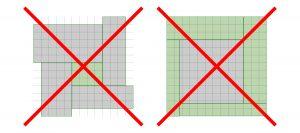Mr. Harrinen is performing another test for his potato field. He is planning to cultivate potatoes in 10 square mounds, all of which are different sizes (1 × 1 m, 2 × 2 m, 3 × 3 m, …, 10 × 10 m).
Southern Ostrobothnia, Mr. Harrinen wants to keep his field as small as possible, minimizing the costs. What is the smallest field that could accommodate his test plots?
The field has to be rectangular in shape. The parts of the field where he doesn’t grow any potatoes will be maintained as green spaces.
Since those areas too must be looked after, they have to be positioned to be accessed easily, with no need for walking through the test plots. At the same time, it must be possible to collect samples from the test plots without walking across any other cultivated areas. In practice, this means that:
a) A green space may not be surrounded by test plots on all sides
b) Other areas with vegetation may not surround a test plot

Below, we have given one possible solution to this problem, but there must be a way of planning the plots such that they take up less space.


